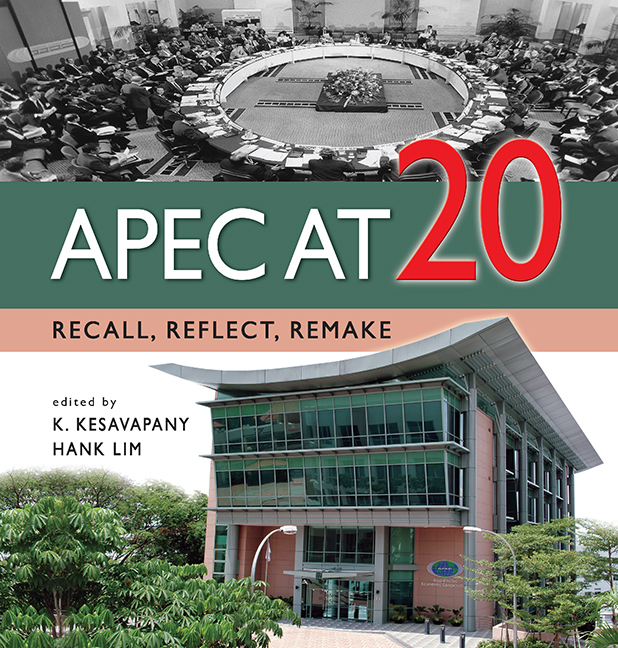Book contents
- Frontmatter
- Frontispiece
- contents
- Foreword by Ambassador Michael Tay
- Preface
- About the Authors
- Asia-Pacific Economic Cooperation (APEC)
- CHAPTER 1 APEC: Genesis and Challenges
- CHAPTER 2 APEC's Origins and its Future
- CHAPTER 3 Four Adjectives Become a Noun: APEC The Future of Asia-Pacific Cooperation
- CHAPTER 4 APEC's Eye on the Prize: Participants, Modality, and Confidence-Building
- CHAPTER 5 APEC: Taking Stock and Looking Ahead
- CHAPTER 6 Revamping APEC's Concerted Unilateral Liberalization
- CHAPTER 7 APEC at 20: Assessment of Trade/Investment Liberalization, Facilitation and Ecotech Activities
- CHAPTER 8 Integrating the Business Community in the APEC Process: Genesis of the Pacific Business Forum
- APPENDICES
- Index
CHAPTER 2 - APEC's Origins and its Future
from Asia-Pacific Economic Cooperation (APEC)
Published online by Cambridge University Press: 21 October 2015
- Frontmatter
- Frontispiece
- contents
- Foreword by Ambassador Michael Tay
- Preface
- About the Authors
- Asia-Pacific Economic Cooperation (APEC)
- CHAPTER 1 APEC: Genesis and Challenges
- CHAPTER 2 APEC's Origins and its Future
- CHAPTER 3 Four Adjectives Become a Noun: APEC The Future of Asia-Pacific Cooperation
- CHAPTER 4 APEC's Eye on the Prize: Participants, Modality, and Confidence-Building
- CHAPTER 5 APEC: Taking Stock and Looking Ahead
- CHAPTER 6 Revamping APEC's Concerted Unilateral Liberalization
- CHAPTER 7 APEC at 20: Assessment of Trade/Investment Liberalization, Facilitation and Ecotech Activities
- CHAPTER 8 Integrating the Business Community in the APEC Process: Genesis of the Pacific Business Forum
- APPENDICES
- Index
Summary
The idea of Asia-Pacific Economic Cooperation (APEC) has evolved over the years, but it continues to be rooted in the reality of the complex political and economic circumstance of the Asia- Pacific economy and polity. Since 1989, when APEC was founded, the institution has changed profoundly. Since 1993, the leaders have met annually and these meetings bring weight to APEC's trans- Pacific political and economic dialogues. The East Asian financial crisis re-focused APEC's economic agenda, albeit more slowly than some might have wished, away from trade liberalization towards financial and other behind-the-border reform. Now the global financial crisis and the longer-term change in the structure of regional and global economic power call for a new look at how APEC might serve its members down the track. Recalling its origins and the processes on which it is built are the first step in considering how APEC might move forward in the years ahead.
Genesis
Although the theoretical underpinnings for an Asia-Pacific community were documented with remarkable prescience by Sir John Crawford as early as 1938, the road towards the establishment of Asia-Pacific Economic Cooperation (APEC) was long and there were many vicissitudes on the way. The idea of APEC was wrought from East Asia's rapid industrialization after the conclusion of the Pacific War. Industrialization created new, and powerful, interactions between East Asia and North America which, in turn, demanded the creation of a new framework for the relationship, first between the United States and Japan, and gradually between America and the whole region, prominently now, China. The debate about what form and function these new relationships should assume was painstaking because the effect that growing regional economic interdependence might have on the East Asian political economy was still uncertain (Woolcott 2003).
The objective was to secure and promote economic cooperation among the wider and wider group of economies in Asia and the Pacific that were becoming more deeply involved in the regional and international economy. Three factors conspired to set the context that shaped the formation of APEC. The first was the Asia Pacific's political, cultural and institutional diversity.
- Type
- Chapter
- Information
- APEC at 20Recall, Reflect, Remake, pp. 17 - 28Publisher: ISEAS–Yusof Ishak InstitutePrint publication year: 2009



